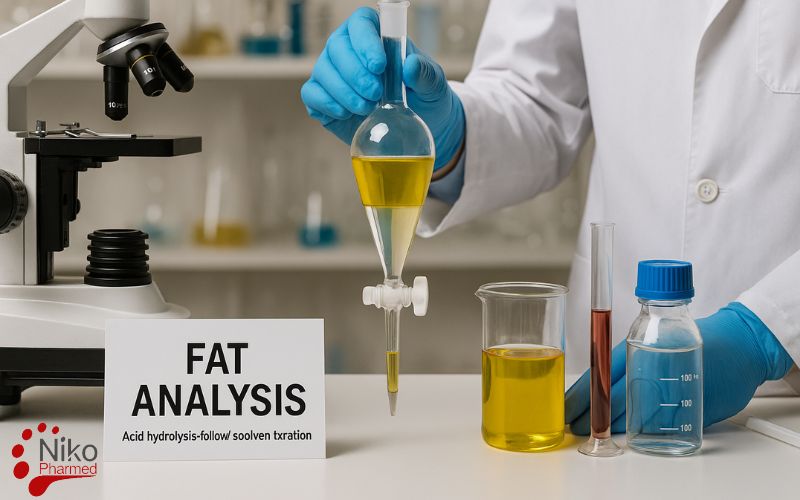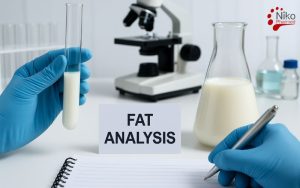What is Fat Analysis?
Fat analysis is a fundamental procedure in food science and nutrition that involves the qualitative and quantitative determination of lipids present in a given sample.
It is essential for assessing the nutritional value, quality, and authenticity of food products, as well as for ensuring compliance with regulatory standards.
Fat analysis encompasses methods that isolate and quantify lipid components, most commonly through solvent extraction techniques such as Soxhlet extraction, or more advanced methods including gas chromatography for fatty acid profiling.
The analysis provides critical data on total fat content, fatty acid composition, and the presence of specific lipid classes, which influence the sensory, functional, and metabolic properties of foods.
By accurately characterizing fat, researchers and industries can monitor dietary intake, optimize food formulations, and detect adulteration, thereby ensuring both consumer safety and product integrity.
Fat Analysis Test Methods
The major methods are:
Gravimetric Solvent Extraction Methods (e.g., Soxhlet Extraction)
Standard References: AOAC Official Method 945.16; ISO 1443.
Principle: The lipid fraction is extracted from a dried, ground sample using a non-polar organic solvent (commonly petroleum ether, hexane, or diethyl ether). The solvent dissolves the fat, which is then recovered after evaporation, and the residue is weighed.
Steps:
- Dry and weigh the sample.
- Place in extraction thimble and extract with boiling solvent in a Soxhlet apparatus.
- Remove solvent, dry the fat residue, and weigh.
Applications: Total crude fat in cereals, meat, dairy, oilseeds.
Advantages: Accurate, well-established, reproducible.
Limitations: Time-consuming (6–18 hours), requires large solvent volumes, not suitable for samples with bound lipids (e.g., phospholipids in membranes).
Acid Hydrolysis Followed by Solvent Extraction
Standard References: AOAC Official Method 922.06; ISO 1444.
Principle: Some fats are bound to proteins or carbohydrates and cannot be extracted directly. Acid hydrolysis (commonly with hydrochloric or sulfuric acid) breaks down the matrix, releasing bound lipids. The hydrolyzed sample is then subjected to solvent extraction.
Steps:
- Hydrolyze sample with strong acid under controlled heating.
- Neutralize, filter, and dry residue.
- Perform Soxhlet or similar solvent extraction.
Applications: Dairy, processed foods, meat products.
Advantages: Ensures complete fat recovery.
Limitations: More laborious, risk of fat oxidation or loss if not carefully controlled.
Mojonnier (Liquid–Liquid Extraction) Method
Standard References: AOAC Official Method 989.05; ISO 1211 (for milk fat).
Principle: Fat is released by digestion of proteins and carbohydrates using ammonia or ethanol, then extracted using a mixture of solvents (typically ether + petroleum ether). The solvent layer is evaporated, and the fat is weighed.
Applications: Widely used in dairy industry (milk, cheese, cream, milk powders).
Advantages: Faster and more efficient than Soxhlet for dairy.
Limitations: Less suitable for non-dairy matrices.
Gerber Method (Volumetric, Dairy-Specific)
Standard References: ISO 2446; AOAC Official Method 2000.18.
Principle: Sulfuric acid digests proteins in milk, releasing fat, which separates upon centrifugation in a calibrated butyrometer. The fat column is read volumetrically.
Applications: Routine milk and dairy fat analysis.
Advantages: Rapid, inexpensive, requires minimal equipment.
Limitations: Dairy-specific, not highly precise compared to gravimetric methods.
Van Gulik Method (Acid Digestion, Dairy-Specific)
Standard References: ISO 11870.
Principle: Similar to Gerber, but uses hydrochloric acid digestion and solvent extraction. Provides more accurate results for cheese and dairy matrices.
Instrumental Methods (Advanced)
- a. Gas Chromatography (GC)
Standard References: AOAC 996.06; ISO 12966.
Principle: Fatty acids are converted into methyl esters (FAMEs) and separated by GC to quantify fatty acid composition and total fat indirectly.
Applications: Nutritional labeling, trans-fat detection, PUFA/SFA analysis.
Advantages: Provides both quantity and composition.
Limitations: Requires expensive equipment, skilled operators.
- b. Nuclear Magnetic Resonance (NMR)
Standard References: ISO 10565.
Principle: Non-destructive measurement of hydrogen nuclei in fat molecules, giving rapid and direct fat content quantification.
Applications: Meat, dairy, oilseeds.
Advantages: Fast, solvent-free.
Limitations: High cost, limited availability.
- c. Near-Infrared Spectroscopy (NIR)
Standard References: ISO 21543.
Principle: Uses absorption of infrared light by C–H bonds in lipids to estimate fat content.
Applications: Rapid screening in industry.
Advantages: Non-destructive, real-time monitoring.
Limitations: Requires calibration against reference methods.
Test Methods Comparative Table
| Method | Principle | Applications | Advantages | Limitations | Standards (AOAC/ISO/AOCS) |
|---|---|---|---|---|---|
| Soxhlet Extraction (Gravimetric) | Continuous solvent extraction of lipids; solvent evaporated and residue weighed. | Cereals, oilseeds, meat, dairy, feed. | Accurate, reproducible, widely accepted reference method. | Time-consuming (6–18 h), high solvent use, not ideal for bound fats. | AOAC 945.16; ISO 1443 |
| Acid Hydrolysis + Solvent Extraction | Matrix digested with strong acid, releasing bound lipids, followed by solvent extraction. | Meat products, processed foods, dairy. | Ensures complete fat recovery. | Laborious; risk of fat oxidation/loss. | AOAC 922.06; ISO 1444 |
| Mojonnier (Liquid–Liquid Extraction) | Fat released using ammonia/ethanol; extracted with ether + petroleum ether, evaporated, weighed. | Dairy (milk, cheese, cream, powders). | Faster and more efficient for dairy than Soxhlet. | Limited to dairy; less suitable for complex foods. | AOAC 989.05; ISO 1211 |
| Gerber Method (Volumetric) | Sulfuric acid digests proteins, fat separates and measured volumetrically in a butyrometer. | Milk and dairy (routine testing). | Rapid, inexpensive, simple. | Dairy-specific; less precise than gravimetric. | AOAC 2000.18; ISO 2446 |
| Van Gulik Method | Hydrochloric acid digestion, fat extracted with solvents, then weighed. | Cheese and dairy products. | More accurate than Gerber for cheese. | Still dairy-specific, labor-intensive. | ISO 11870 |
| Gas Chromatography (GC) | Fatty acids converted to methyl esters (FAMEs), separated by GC for quantification & profiling. | Nutritional labeling, trans-fat detection, fatty acid composition. | High precision, provides composition + total fat. | Expensive, requires expertise, not primary for crude fat. | AOAC 996.06; ISO 12966 |
| Nuclear Magnetic Resonance (NMR) | Measures hydrogen nuclei in lipids directly (non-destructive). | Meat, dairy, oilseeds, rapid industrial QC. | Solvent-free, fast, non-destructive. | Expensive equipment, calibration needed. | ISO 10565 |
| Near-Infrared Spectroscopy (NIR) | Measures absorption of IR light by C–H bonds in lipids. | Rapid screening in dairy, cereals, meat, oils. | Very fast, non-destructive, real-time monitoring. | Requires calibration; less accurate without reference methods. | ISO 21543 |
Key Insight:
- Reference methods for regulatory purposes: Soxhlet and Acid Hydrolysis (gravimetric).
- Routine dairy testing: Gerber, Mojonnier, Van Gulik.
- Advanced profiling: GC, NMR, NIR (composition, rapid screening, industrial automation).
Nikopharmed Fat Analysis Laboratory
Accreditation and Global Recognition
ISO/IEC 17025-certified and ILAC-accredited ensures that your results are globally accepted and fully compliant with international regulatory requirements.
Technical Excellence
Our laboratory is equipped with validated solvent extraction systems, advanced gravimetric platforms, and state-of-the-art chromatographic technologies. From Soxhlet and Mojonnier methods to advanced GC profiling of fatty acids, we guarantee accurate, reproducible, and matrix-specific determinations across food, feed, pharmaceutical, and nutraceutical products.
Regulatory-Ready Reporting
We deliver traceable, statistically validated reports aligned with international standards—supporting nutritional labeling, authenticity verification, and regulatory compliance for both domestic and global markets.
Confidentiality and Data Integrity
All testing follows strict confidentiality protocols with 21 CFR Part 11-compliant electronic data systems, ensuring secure, traceable, and tamper-proof results.
Cost-Effective Solutions
We provide competitive, tailored pricing for enterprises, manufacturers, and regulatory agencies—delivering efficient compliance support without compromising analytical quality.
To request testing or a complimentary consultation contact Nikopharmad
Your Trusted Partner in Fat Analysis
By partnering with Nikopharmed, clients gain access to a globally accredited laboratory committed to scientific accuracy, regulatory compliance, and complete data confidentiality.
Whether determining total fat content, profiling fatty acids, ensuring product authenticity, or meeting international trade requirements, our expertise in Fat Analysis guarantees accurate, reliable, and internationally recognized results helping you achieve compliance faster and with confidence.


